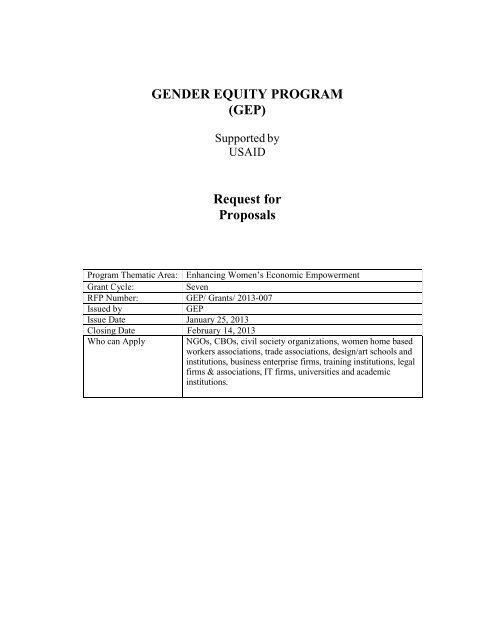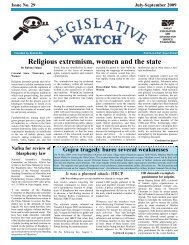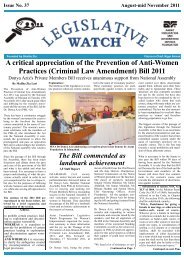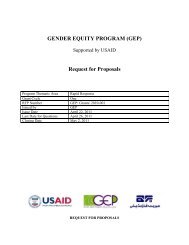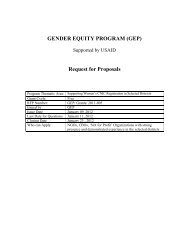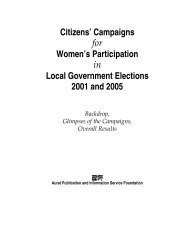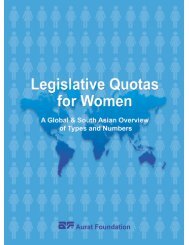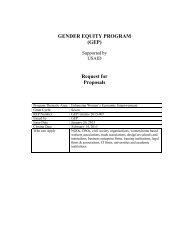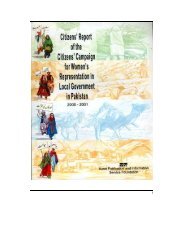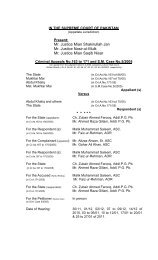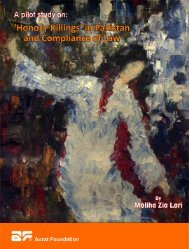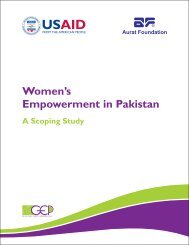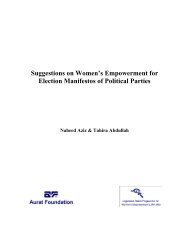Request for Proposals - Aurat Foundation
Request for Proposals - Aurat Foundation
Request for Proposals - Aurat Foundation
Create successful ePaper yourself
Turn your PDF publications into a flip-book with our unique Google optimized e-Paper software.
GENDER EQUITY PROGRAM<br />
(GEP)<br />
Supported by<br />
USAID<br />
<strong>Request</strong> <strong>for</strong><br />
<strong>Proposals</strong><br />
Program Thematic Area: Enhancing Women’s Economic Empowerment<br />
Grant Cycle:<br />
Seven<br />
RFP Number: GEP/ Grants/ 2013-007<br />
Issued by<br />
GEP<br />
Issue Date January 25, 2013<br />
Closing Date February 14, 2013<br />
Who can Apply NGOs, CBOs, civil society organizations, women home based<br />
workers associations, trade associations, design/art schools and<br />
institutions, business enterprise firms, training institutions, legal<br />
firms & associations, IT firms, universities and academic<br />
institutions.
REQUEST FOR PROPOSALS<br />
SUBJECT: <strong>Request</strong> <strong>for</strong> <strong>Proposals</strong>/RFP Number: GEP/ Grants / 2013 – 007<br />
Sub-Grants <strong>for</strong> Cycle Seven: Enhancing Women’s Economic<br />
Empowerment<br />
<strong>Aurat</strong> <strong>Foundation</strong> in collaboration with The Asia <strong>Foundation</strong> will award a series of sub-grants to<br />
local Pakistani organizations with the objective of affecting real behavioral change and<br />
contributing to a productive gender debate within Pakistan. These grants are made possible with<br />
the financial support of USAID under the Gender Equity Program (GEP). Various grant cycles<br />
will be advertised over a five year period ending August 2015. The program is envisioned to<br />
impact on a national level.<br />
<strong>Aurat</strong> <strong>Foundation</strong> invites and welcome the submission of proposals against the terms of<br />
reference mentioned in Section Three of this RFP by registered civil society not-<strong>for</strong>-profit<br />
organizations, private organizations, universities and training institutions among others.<br />
Frequently Asked Questions regarding GEP and/or the scope of work delineated in this RFP are<br />
available on the website. Completed proposals should be submitted via post (hardcopy) by<br />
close of business on February 14, 2013 to the postal address given below.<br />
This RFP does not constitute a commitment to make an award on the part of GEP or any agency<br />
implementing or financing the project. The project will not pay <strong>for</strong> any cost(s) <strong>for</strong> the preparation<br />
or submission of proposals. GEP reserves the right to reject any or all proposals in the best<br />
interest of the project objectives.<br />
Grants Management Committee<br />
Gender Equity Program (GEP)<br />
Email: info.gep@af.org.pk<br />
procurement.gep@af.org.pk<br />
House 12, Street 12, F7/2, Islamabad 44000<br />
2
Contents<br />
Section 1: Summary In<strong>for</strong>mation .................................................................................................... 4<br />
1.1 Vision and Goal .................................................................................................................... 4<br />
1.2 Objectives/Priority Areas ...................................................................................................... 4<br />
Section 2: Sub-Grant In<strong>for</strong>mation................................................................................................... 5<br />
2.1 Priority Area <strong>for</strong> Cycle Two ................................................................................................. 5<br />
2.2 Financial Allocation.............................................................................................................. 5<br />
2.3 Closing Date.......................................................................................................................... 5<br />
2.4 <strong>Request</strong>s <strong>for</strong> In<strong>for</strong>mation ...................................................................................................... 5<br />
2.5 Award In<strong>for</strong>mation................................................................................................................ 5<br />
Section 3: Scope of Work ............................................................................................................... 6<br />
3.1 Time Period........................................................................................................................... 6<br />
3.2 Location................................................................................................................................................................ 6<br />
3.3 Detailed Scope of Work <strong>for</strong> Cycle Two ............................................................................... 6<br />
Section 4: Baseline and Reporting ................................................................................................ 20<br />
Section 5: Proposal Process .......................................................................................................... 20<br />
5.1 Who should apply ............................................................................................................... 20<br />
5.2 Eligibility Criteria ............................................................................................................... 20<br />
5.3 How to apply....................................................................................................................... 20<br />
5.4 Sub-Grant Application Format ........................................................................................... 21<br />
5.5 Evaluation Criteria……………………………………………………………………………………23<br />
5.6 Award Criteria.................................................................................................................... ………24<br />
5.7 Notification ......................................................................................................................... 24<br />
Section 6: Certifications................................................................................................................ 25<br />
ANNEX 1: Required Certifications .............................................................................................. 26<br />
ANNEX 2: Sample Work plan .................................................................................................... 35<br />
ANNEX 3: Sample Budget…………………………………………………………………………………...36<br />
3
Section 1: Summary In<strong>for</strong>mation<br />
In support of the Government of Pakistan's gender policies (National Plan of Action <strong>for</strong> Women,<br />
National Policy <strong>for</strong> Empowerment and Development of Women, and Gender Re<strong>for</strong>m Action<br />
Plans) the <strong>Aurat</strong> <strong>Foundation</strong> (AF) and The Asia <strong>Foundation</strong> (TAF), with financial support from<br />
USAID, will implement a five year, Gender Equity Program (GEP). The program aims at<br />
advancing women's human rights and empowerment. Under GEP, a series of sub-grants will be<br />
awarded to local Pakistani organizations with the objective of affecting real behavioral change<br />
and contributing to a productive gender debate within Pakistan. The Program will work mainly<br />
through the award of approximately 400 sub-grants to local organizations over the course of five<br />
years, and will mobilize local experience, expertise, and knowledge in pursuit of its Objectives.<br />
1.1 Vision and Goal<br />
The vision of the Program is to generate widespread societal demand and commitment <strong>for</strong> a<br />
socially just, democratic, caring and gender-responsive society in Pakistan, where all citizens,<br />
women and men, are recognized as equal, with the right to lead their lives with self-respect and<br />
dignity. The goal of the Program will be to facilitate behavioral change: in particular to facilitate<br />
citizens active participation in the process of social change and governance at all levels,<br />
enabling women to access in<strong>for</strong>mation, resources and institutions, acquire control over their lives<br />
and improve attitudes and behavior towards women and their concerns.<br />
1.2 Objectives/Priority Areas<br />
<br />
<br />
<br />
<br />
Objective 1: Enhancing gender equity by expanding women’s access to justice and<br />
women’s human rights.<br />
Objective 2: Increasing women’s empowerment by expanding knowledge of their rights<br />
and opportunities to exercise their rights in the workplace, community, and home.<br />
Objective 3: Combating Gender Based Violence (GBV)<br />
Objective 4: Strengthening the capacity of Pakistani organizations that advocate <strong>for</strong><br />
gender equity, women’s empowerment and the elimination of GBV.<br />
4
Section 2: Sub-Grant In<strong>for</strong>mation<br />
2.1 Priority Area <strong>for</strong> Cycle Seven<br />
GEP’s seventh grant cycle is in support of enhancing women’s economic empowerment across<br />
Pakistan. Sub-grants on various themes are to be awarded to facilitate an enabling environment,<br />
ensure provision of required services, enhance skills and create opportunities aimed at improving<br />
women’s livelihood options. An improvement in the identified services, skills and opportunities<br />
are to enable women’s choices, the right to exercise these and empower themselves through an<br />
expansion of livelihood generation. These set of sub-grants will also demonstrate women’s role<br />
and abilities to actively participate in, and contribute to, the economic progress of Pakistan when<br />
provided with equal opportunities.<br />
2.2 Financial Allocation<br />
GEP sub-grant awards will fall into three distinct tiers:<br />
Below $25,000<br />
$25,000 - $100,000<br />
Over $100,000<br />
Tier 1 awards are expected to be most frequent. Tier 2 and Tier 3 sub-grant awards will be less<br />
common. Individual ceilings will be allocated per sub-grant and will be detailed in the sub-grant<br />
solicitations. All budgets will be subject to strict scrutiny to prevent excessive allocation.<br />
2.3 Closing Date<br />
The final date <strong>for</strong> submission of the completed proposal application package and all required<br />
documents is February 14, 2013. No extensions will be given.<br />
2.4 <strong>Request</strong>s <strong>for</strong> In<strong>for</strong>mation<br />
Please note that verbal and telephonic requests will not be entertained. FAQs are posted on<br />
GEP webpage.<br />
2.5 Award In<strong>for</strong>mation<br />
1. Award Type<br />
Simplified Grant or Fixed Obligation Grant (Simplified Grant Format (ADS 303.3.24))<br />
2. Timing<br />
The review process <strong>for</strong> all sub-grants will take 6-8 weeks, following which all successful<br />
applicants will be contacted.<br />
5
Section 3: Scope of Work<br />
3.1 Time Period<br />
Each sub-grant has a suggested time period within which the project activities must be<br />
completed.<br />
3.2 Location<br />
Applicants are requested to mention their selected sub-grant number and location (districts)<br />
clearly in their applications.<br />
3.3 Detailed Scope of Work <strong>for</strong> Cycle Seven<br />
The following section lists the sub-grants by thematic area and defines the conceptual design,<br />
location, budget, minimum suggested outputs and time period under each.<br />
1. Promoting improved livelihoods <strong>for</strong> in<strong>for</strong>mal sector workers (twelve sub-grants up to<br />
$40,000 each)<br />
Sub-grant 168: Lahore<br />
Sub-grant 169: Multan<br />
Sub-grant 170: Sargodha<br />
Sub-grant 171: Sialkot<br />
Sub-grant 172: Peshawar<br />
Sub-grant 173: Haripur<br />
Sub-grant 174: Swat<br />
Sub-grant 175: Hyderabad<br />
Sub-grant 176: Karachi<br />
Sub-grant 177: Quetta<br />
Sub-grant 178: Muzaffarabad<br />
Sub-grant 179: Skardu<br />
A significant number of women are employed in the in<strong>for</strong>mal sector across Pakistan. While home<br />
based work constitutes a critical opportunity <strong>for</strong> women to enable their incomes, the prevalent<br />
environment in which they function allows <strong>for</strong> limited empowerment. These nine grants are in<br />
support of greater organization, enhancement of craft/product and establishment of a direct access<br />
to the market. The aims of these grants are to:<br />
Mobilize home based workers, specifically craftswomen and artisans, <strong>for</strong> the <strong>for</strong>mation of<br />
village-level groups/committees;<br />
Work with the home based worker groups/committees to refine their existing skills and<br />
make their products market-competitive (with input from an additional GEP partner<br />
working on product design and development);<br />
Establish Trade Facilitation & Communication Centers (TFCC) at the district level to act<br />
as a marketing/sales/communication point <strong>for</strong> the home based workers<br />
This sub-grant envisages an enhancement of women’s existing work, their skills and their craft to<br />
improve their income generating abilities in the identified districts. It involves an initial mapping<br />
to identify the range of handicrafts and/or products being produced by women in these areas, and<br />
the related geographical hubs in which these are based. This would be followed up by ef<strong>for</strong>ts to<br />
6
organize these women, where they remain unorganized, or to re-invigorate these groups where<br />
they have become stagnant or inactive. These groups are critical plat<strong>for</strong>ms to come together, share<br />
experiences, foster a culture of mutual learning and mobilize support mechanisms <strong>for</strong> home based<br />
workers. It will also provide an opportunity to rally these groups on their rights as well as link<br />
them with existing social security schemes. Given the contextual realities, such are to be<br />
organized according to their distinct handicrafts/products.<br />
As part of this sub-grant an extensive skill development and product enhancement initiative will<br />
also be undertaken. While the rolling out of the skill development sessions/workshops will be the<br />
responsibility of the chosen sub-grantee, GEP is also soliciting the expertise of a design school or<br />
academy under a separate sub-grant. This chosen partner will be working with the district-level<br />
partners to work on developing the identified crafts, innovating and making these market-relevant.<br />
The said partner will also be working on marketing these new/improved products to break out of<br />
their existing niche and cater to a wider and better paying audience.<br />
The sub-grant will also set up Trade Facilitation & Communication Centers (TFCC) that are<br />
expected to be a long-term establishment catering to the ongoing needs of women home based<br />
workers. These can be an extension or enhancement of existing centers already being run by the<br />
applicant organization. The TFCCs are expected to include a marketing space <strong>for</strong> display and sale<br />
of women’s improved products as well as facilitating linkages with potential buyers. Furthermore,<br />
these TFCCs will also function as women-friendly communication hubs, catering to the home<br />
based workers as well as other women, where all the necessary In<strong>for</strong>mation and Communication<br />
Technology (ICT) facilities are made readily available.<br />
Suggested time period: 12 months<br />
Minimum suggested outputs:<br />
Identify groups of artisans and existing skill base in the chosen district<br />
Women home based workers mobilized and organized into 6 village-level<br />
groups/committees, at a minimum covering two tehsils/talukas<br />
3 skill development workshops organized <strong>for</strong> each of the 6 village-level<br />
groups/committees, one per quarter<br />
Coordination maintained, and support given to, the Product Development and<br />
Marketing sub-grant partner<br />
Trial packs containing the required raw material distributed amongst the target women<br />
<strong>for</strong> improved product development<br />
Linkages created with existing social security and benefit schemes<br />
Database developed and maintained to track economic status of women workers<br />
1 Trade Facilitation & Communication Center established<br />
District-level planning workshop organized bringing together the village-level<br />
groups/committees <strong>for</strong> next steps (post sub-grant life)<br />
Please note that the above are minimum requirements under this sub-grant. Preference will be<br />
given to organizations with demonstrated previous experience and to proposals that contain<br />
further innovation in the planned activities, while targeting a larger group of women.<br />
7
Who should apply<br />
Home based women workers associations, trade associations, CBOs and NGOs based in the<br />
selected districts are encouraged to apply <strong>for</strong> this grant.<br />
2. Product development, refinement and facilitation of market integration (one sub-grant<br />
up to $100,000)<br />
Sub-grant 180: National<br />
Pakistan’s home based workers and women artisans have a diverse skill base and produce a<br />
variety of handicrafts. Their skills, often passed down generations, <strong>for</strong>m the basis of their<br />
livelihoods and are the resource they rely upon <strong>for</strong> earning an income. While their existing skill<br />
base provides a unique opportunity to enhance their incomes further and boost empowerment<br />
levels, the demand <strong>for</strong> their craft and the monetary returns it offers is fast diminishing. There is<br />
little professional guidance available to these women to bring innovation into their design,<br />
develop market-relevant products, improve the overall quality of their work, or successfully<br />
integrate their wares into a high-return market.<br />
Through this sub-grant ef<strong>for</strong>t to work with these women to bring innovation into their traditional<br />
crafts/products, facilitate development of value chains and optimize marketing opportunities, is<br />
being envisioned. The aims of this sub-grant are to:<br />
<br />
<br />
<br />
<br />
<br />
Identify potential market opportunities <strong>for</strong> products based on traditional skills;<br />
Design and develop a range of innovative products appealing to the identified markets;<br />
Test, modify and refine the products until they are ready <strong>for</strong> production;<br />
Work with women artisans to build their capacities on the new products, while enhancing<br />
their understanding of contemporary designs, color palettes and marketability;<br />
Create linkages between the women artisans/ home based workers and the identified<br />
markets, and successfully integrate the new products into the identified market niches<br />
This sub-grant will work in close coordination with the district-level sub-grants outlined above<br />
(under 168-177). The existing skill base and range of products being developed in these districts<br />
will be identified under 168-177. The successful applicant <strong>for</strong> this sub-grant will coordinate with<br />
the district partners and pursue refinement and further development of the existing products.<br />
Suggested time period: 12 months<br />
Minimum suggested outputs:<br />
Mapping exercise conducted to spot existing and upcoming market opportunities <strong>for</strong><br />
the identified traditional arts and craft products<br />
Sets of innovative products developed <strong>for</strong> each of the ten districts<br />
Facilitate skill development and product enhancement workshops organized under subgrants<br />
168-177 <strong>for</strong> the village-level home based workers groups/committees<br />
Promote and leverage the new products in the identified markets<br />
Integrate the products into the identified market opportunities and establish linkages of<br />
8
women artisans to these facilities<br />
Coordination meetings organized at the regional level, at grant opening and closing<br />
Please note preference will be given to applicants with strong previous experience in product<br />
design and development, while demonstrating understanding of market trends and previous<br />
success in market integration of products.<br />
Who should apply<br />
Design schools/ institutions, art schools, training academies, business enterprise firms are<br />
encouraged to apply <strong>for</strong> this grant<br />
3. Enhancing women workers awareness on their rights and labor laws (seventeen subgrants<br />
up to $35,000 each)<br />
Sub-grant 181: Lahore<br />
Sub-grant 182: Multan<br />
Sub-grant 183: Faisalabad<br />
Sub-grant 184: Sahiwal<br />
Sub-grant 185: Rahim Yar Khan<br />
Sub-grant 186: Sialkot<br />
Sub-grant 187: Karachi (Site area)<br />
Sub-grant 188: Karachi (Korangi Industrial Area)<br />
Sub-grant 189: Hyderabad<br />
Sub-grant 190: Sukkur<br />
Sub-grant 191: Lasbela<br />
Sub-grant 192: Peshawar<br />
Sub-grant 193: Haripur<br />
Sub-grant 194: Skardu<br />
Sub-grant 195: Gilgit<br />
Sub-grant 196: Islamabad Capital Territory (including Rawalpindi)<br />
Sub-grant 197: Mirpur<br />
Twelve sub-grants will be awarded in the select districts across Pakistan to enhance awareness<br />
amongst women workers around their rights and increase knowledge related to labor laws. The<br />
sub-grants would focus on the districts which are existing industrial and/or other economic<br />
activity hubs (<strong>for</strong>mal and in<strong>for</strong>mal) in the five provinces and aim to strengthen their ability as an<br />
in<strong>for</strong>med agency of change.<br />
These sub-grants seek to empower women workers by enhancing knowledge of their labor rights,<br />
and organize them into groups. This would include women workers from both <strong>for</strong>mal as well as<br />
in<strong>for</strong>mal sectors. As part of the sub-grant women workers will also be enabled to engage with<br />
employers where applicable/possible.<br />
Through this initiative women factory/industrial workers, home based workers and daily wage<br />
women workers will be brought together on one plat<strong>for</strong>m – an innovative mechanism <strong>for</strong> their<br />
engagement. These grants will ensure that the district level context is kept in consideration while<br />
9
selecting the women workers’ group. GEP will engage with another entity at the national level to<br />
design and develop the training modules. This engagement will be supported by GEP through a<br />
separate sub-grant. These modules will be utilized in workshops held across the provinces in all<br />
the select districts, effectively raising awareness and understanding of women workers regarding<br />
their labor rights. Various sub-categories/industries where women are working would be targeted<br />
and the geographical spread of the workshops would correlate to the working women population<br />
split in each region.<br />
Preference will be given to organizations that propose cost-effective options achieving the<br />
deliverables under the sub-grants.<br />
Suggested time period: 12 months<br />
Minimum suggested outputs:<br />
Context analysis of the select women workers’ groups based upon the district and<br />
provincial scenarios<br />
5 training workshops held <strong>for</strong> women workers <strong>for</strong> 25-30 women workers in each<br />
workshop<br />
One group of women workers’ (from <strong>for</strong>mal and in<strong>for</strong>mal sectors, both) representative is<br />
<strong>for</strong>med at the regional level and linkage of <strong>for</strong>mal sector women workers with the trade<br />
unions<br />
Vocation-specific and/or district/provincial <strong>for</strong>ums <strong>for</strong> women workers established and at<br />
least three conventions held of these <strong>for</strong>ums<br />
The employers (from <strong>for</strong>mal sector) are engaged to build their understanding on Sexual<br />
Harassment Act and women friendly HR policies in place<br />
Establish linkages between the women worker <strong>for</strong>ums and the provincial departments of<br />
Labor<br />
Who should apply<br />
NGOs, CBOs, advocacy groups and training institutions are encouraged to apply <strong>for</strong> this subgrant.<br />
4. Awareness-raising and policy advocacy on women’s rights and labor laws <strong>for</strong> women<br />
workers (one sub-grant up to $75,000)<br />
Sub-grant 198: National<br />
This grant is to act as a coordinating body linked to the district-level advocacy grants outlined<br />
above. The sub-grant aims at:<br />
Undertaking a thorough analysis of labor policies, women workers related legal provisions<br />
and lacunas in the existing legislation regarding women working in <strong>for</strong>mal and in<strong>for</strong>mal<br />
sector of the economy<br />
Developing a module that encompasses concepts of women’s rights and labor laws<br />
(distinct in<strong>for</strong>mation as applicable to <strong>for</strong>mal vs. in<strong>for</strong>mal women workers)<br />
Playing a coordination role <strong>for</strong> the district level sub-grantees<br />
Arranging ToTs of the sub-grantees from select districts<br />
10
Provincial and national level consultations with policy makers and parliamentarians to<br />
share and discuss recommendations and enlist their support <strong>for</strong> the required amendments<br />
in the existing legislation<br />
Under the sub-grant a specific module will be developed, encompassing concepts of women’s<br />
rights and labor laws (regarding <strong>for</strong>mal and in<strong>for</strong>mal sectors both). The successful organization<br />
will be expected to undertake an extensive review work of the existing awareness-raising and<br />
legal material, identify gaps and develop the module accordingly. The module would be<br />
customized (reflective of provincial level labor laws) according to the ground realities of the<br />
particular province in question.<br />
The training module would also cater to the needs of enhancing awareness of women workers<br />
groups around the issues of women’s rights and labor laws. It is envisioned that a review of<br />
existing materials and modules will be conducted to identify gaps, and a consultative process will<br />
be adapted to improve design. Focus group discussions may be held with women workers’<br />
groups, whereby draft recommendations are compiled by the moderator that later in<strong>for</strong>m training<br />
module content and design.<br />
The consultative process <strong>for</strong> module development, and a thorough analysis of labor policies and<br />
laws, will enable the sub-grantee to come up with policy recommendations which will then<br />
become the basis of extensive policy advocacy at the national/provincial level. The sub-grantee<br />
will coordinate with the district level sub-grantees to put <strong>for</strong>th collective demands in front of the<br />
policy makers at all levels.<br />
Suggested time period: 14 months<br />
Minimum suggested outputs:<br />
Conduct analysis of existing labor laws and policies at provincial and national level<br />
Hire services of a legal expert as the key resource<br />
Develop and test a set of training module through a consultative process at the regional<br />
level<br />
Organize a grants opening meeting <strong>for</strong> the district level sub-grantees (under sub-grants<br />
181-197 above), with participation of two persons per organization<br />
Conduct Training of Trainers (ToTs) <strong>for</strong> the district level sub-grantees under sub-grants<br />
181-197 (it is expected that the ToTs be run in two batches <strong>for</strong> a duration of two days each<br />
and a minimum of two staff members from each district level sub-grantee will participate<br />
in the ToT sessions)<br />
Conduct provincial and national level seminars/consultations<br />
Organize a grants closing meeting <strong>for</strong> the district level sub-grantees (under sub-grants<br />
181-197 above), with participation of two persons per organization<br />
Who should apply<br />
National level NGOs, advocacy groups, legal firms & associations and training institutions are<br />
encouraged to apply <strong>for</strong> this sub-grant.<br />
5. Advocacy campaign <strong>for</strong> Allocation and Rehabilitation of Women Friendly Spaces<br />
11
(twenty sub-grants between $25,000 - $60,000)<br />
Sub-grant 199: Muzaffarabad (up to $25,000)<br />
Sub-grant 200: Quetta (up to $30,000)<br />
Sub-grant 201: Sibbi (up to $25,000)<br />
Sub-grant 202: Lasbela (up to $25,000)<br />
Sub-grant 203: Skardu (up to $25,000)<br />
Sub-grant 204: Islamabad Capital Territory (including Rawalpindi) (up to $ 45,000)<br />
Sub-grant 205: Peshawar (up to $ 30,000 each)<br />
Sub-grant 206: Swat (up to $ 25,000 each)<br />
Sub-grant 207: Lahore (up to $45,000)<br />
Sub-grant 208: Multan (up to $30,000)<br />
Sub-grant 209: Faisalabad (up to $30,000)<br />
Sub-grant 210: Sialkot (up to $30,000)<br />
Sub-grant 211: Sahiwal & Sargodha (up to $45,000)<br />
Sub-grant 212: Rajan pur (up to $25,000)<br />
Sub-grant 213: Rahim Yar Khan (up to $25,000)<br />
Sub-grant 214: Muzaffargarh (up to $25,000)<br />
Sub-grant 215: Karachi (up to $60,000)<br />
Sub-grant 216: Hyderabad (up to $40,000)<br />
Sub-grant 217: Jacobabad & Sukkur (up to $45,000)<br />
Sub-grant 218: Benazirabad (up to $25,000)<br />
Sub-grants will be awarded to increase women’s empowerment by working towards creation of<br />
women friendly environment facilitating their mobility and economic participation.<br />
The selected organizations are expected to design and undertake an advocacy campaign geared<br />
towards allocation and rehabilitation of toilets <strong>for</strong> women at private sector entities/industries that<br />
employ significant numbers of women and courts frequented by women in the designated<br />
districts. Furthermore, the sub-grant also envisions advocacy <strong>for</strong> establishment of day care<br />
facilities at these private companies/industries and waiting areas <strong>for</strong> women in district court<br />
premises. The value addition through these inputs is expected to fill the gaps in the existing<br />
facilities and services that hinder women in effectively accessing regular employment, their<br />
retention and professional growth. Similarly, the intervention at the district courts level is<br />
expected to provide an enabling environment <strong>for</strong> women to access the legal system.<br />
The first component of the sub-grants seeks to undertake advocacy ef<strong>for</strong>ts with employers ranging<br />
from mainstream private companies, industries as well as chambers of commerce in the selected<br />
districts. The proposal should include a detailed advocacy plan and strategy which may include,<br />
but not limited to, the following activities:<br />
Conducting a series of orientation sessions with existing employers at various tiers focusing<br />
on the importance of catering to the practical needs of women employees and providing a<br />
more conducive environment at the workplaces<br />
Holding meetings to advocate <strong>for</strong> allotment of female toilets and setting up of day care<br />
facilities<br />
Developing and disseminating manuals laying out the guidelines <strong>for</strong> gender sensitive HR<br />
policies including Sexual Harassment Act so that women employees are able to work at<br />
their maximum potential<br />
12
Developing and disseminating In<strong>for</strong>mation, Education and Communication (IEC) material<br />
The second component focuses on an advocacy campaign <strong>for</strong> the allocation of designated toilets<br />
and private waiting areas <strong>for</strong> women in court premises at the district level. The campaign will<br />
target bar associations and councils in their independent capacity as representative bodies of the<br />
lawyers in the district.<br />
The organizations will be expected to submit a plan of action that details its engagement strategy<br />
with the bar associations/councils and the administrative units of district and high courts.<br />
Following a systematic approach, the selected organization will seek to establish a<br />
liaison/partnership with these elected bodies of lawyers by signing a memorandum of<br />
understanding.<br />
The selected organization will work in tandem with bar associations and councils to seek the<br />
allotment of these toilets within the existing lavatories and waiting areas at court premises by<br />
developing and disseminating messages and IEC material related to women friendly spaces within<br />
the court premises. Meetings with the designated people in the administrative units at the courts<br />
will be held to roll the process <strong>for</strong>ward.<br />
Construction of new facilities does not come under the scope of this sub grant. However, minimal<br />
rehabilitation support maybe provided towards the uplifting of toilets based on an assessment<br />
exercise. Similarly basic support may also be provided <strong>for</strong> setting up waiting areas.<br />
Suggested time period: 12 months<br />
Minimum suggested outputs:<br />
Advocacy with corporate sector entities:<br />
Advocacy plan laying out the strategy and details of the campaign<br />
At least 2 one-day workshops with the respective provincial chambers of commerce and<br />
industries<br />
At least 20 one-day workshops with mainstream private sector companies and industries in<br />
the selected districts<br />
Development and dissemination of detailed guidelines on gender-sensitive HR policies (in<br />
Urdu, English and Sindhi)<br />
Development and dissemination plan <strong>for</strong> the IEC material<br />
10 success stories of corporate entities allocating space <strong>for</strong> day care facilities as a result of<br />
GEP engagement<br />
10 success stories of corporate entities/industries designating separate toilet facilities <strong>for</strong><br />
women<br />
Advocacy with elected bodies of lawyers and administrative units within courts:<br />
Memoranda of Understanding (MoU) with bar associations/counsels at district level<br />
Advocacy plan laying out details of engagement with the elected bodies<br />
Development and dissemination of detailed guidelines <strong>for</strong> gender-sensitive environment at<br />
the district court premises<br />
Development and dissemination of messages and IEC material related to women friendly<br />
13
spaces within the court premises<br />
Establishment of one waiting room <strong>for</strong> women in each district court<br />
Rehabilitation of one toilet <strong>for</strong> women within the premises of each district court<br />
Who should apply<br />
For profit, as well as not-<strong>for</strong>-profit, organizations with prior experience working with the bar<br />
associations/councils, corporate sector and undertaking advocacy campaigns to promote women<br />
rights are encouraged to apply <strong>for</strong> these sub-grants.<br />
6. Supporting female graduates access into In<strong>for</strong>mation Technology (IT) sectors through<br />
internship programs (ten sub-grants up to $75,000 each)<br />
Sub-grant 219: Lahore<br />
Sub-grant 220: Multan<br />
Sub-grant 221: Faisalabad<br />
Sub-grant 222: Karachi<br />
Sub-grant 223: Hyderabad<br />
Sub-grant 224: Peshawar<br />
Sub-grant 225: Islamabad Capital Territory (including Rawalpindi)<br />
Sub-grant 226: Muzaffarabad<br />
Sub-grant 227: Mirpur<br />
Sub-grant 228: Gilgit<br />
In<strong>for</strong>mation technology (IT) has traditionally remained an untapped sector <strong>for</strong> women. The<br />
barriers into this technical employment sector include lack of specialized training and access to<br />
entry points into the IT job market. However, given the huge market share in employment, the<br />
in<strong>for</strong>mation technology sector offers huge employment potential <strong>for</strong> women. To this end, GEP<br />
envisions support to women having fresh graduate degrees by providing specialized training and<br />
internship placements. The value addition through these inputs is expected to capacitate women,<br />
provide relevant entry points into the job market as well as the exposure that will increase their<br />
chances of finding long-term employment in the sector.<br />
The selected organizations will be expected to:<br />
Conduct a detailed need assessment and identification of the required IT skills to build the<br />
capacity of women graduates and enhance their chances of employability<br />
Conduct a mapping and selection of women beneficiaries (fresh graduate) from IT<br />
departments of universities<br />
Mapping of corporate sector entities where women can be placed on internships <strong>for</strong> a<br />
period of 6-months<br />
Advocacy regarding the establishment of women friendly environment, sexual harassment<br />
at work places, gender sensitization and laws on women protection will be initiated in the<br />
selected companies where the internees are placed<br />
<br />
<br />
Develop and pre-test training material based on the identified needs<br />
Hire services of consultant in close consultation with GEP team, to develop/comprehend a<br />
manual from the already developed contents under GEP, used to impart the awareness<br />
raising training with detailed guidelines <strong>for</strong> delivery of training on Sexual Harassment Act,<br />
14
labor laws, women friendly spaces etc.<br />
Arrange placement in companies of women <strong>for</strong> 6 months internships, with a small<br />
monthly stipend. This learning opportunity is likely to increase their employment choices<br />
and provide linkages to fresh women graduates<br />
It is hoped that the internees will serve as agents of change by initiating, advocacy regarding the<br />
establishment of women friendly environment, sexual harassment at work places, gender<br />
sensitization and laws on women protection in the selected companies where the internees are<br />
placed.<br />
Potential Organizations applying <strong>for</strong> this sub-grant must identify in each province the district<br />
having the various Public/ private universities graduates that they propose <strong>for</strong> partnership and<br />
potential industries/firms <strong>for</strong> placement.<br />
Suggested time period: 12 months<br />
Minimum suggested outputs:<br />
Conduct baseline in the first 1.5 month with the scope including, identification of<br />
employable IT skills, identification of potential companies where internees can be placed,<br />
Mapping and selection of women beneficiaries (fresh graduates) from IT departments of<br />
universities and recommendations on skills on which women internees should be trained<br />
Hire services of a gender expert as the key resource <strong>for</strong> design and delivery of training<br />
manual (from content already under GEP) on Sexual Harassment Act, labor laws,<br />
promoting women friendly spaces<br />
Develop and pre-test training modules on IT employable skills<br />
Deliver three specialized trainings <strong>for</strong> the trainee graduates (each training consisting of a<br />
minimum 20 participants <strong>for</strong> the duration of 3 weeks)<br />
Conduct three training workshops on women’s rights, labor laws, Sexual Harassment Act<br />
and promotion of women friendly spaces (each training will consist of a minimum of 20<br />
participants and will be <strong>for</strong> a duration of 3 days)<br />
Conduct seven workshops (one in each city) with employers to orient them to women<br />
friendly workplaces, labor laws and Sexual Harassment Act<br />
Develop and maintain a database to keep track of the internees and their employment<br />
status<br />
120 IT women graduates placed on internships with entities <strong>for</strong> six months<br />
Who should apply<br />
IT firms, academic & training institutions and NGOs are encouraged to apply <strong>for</strong> this grant.<br />
7. Training of sub-grantees on Project Cycle Management (PCM) and Financial<br />
Management (FM), Gender sensitization and women friendly laws (one sub-grant up to<br />
$150,000)<br />
Sub-Grant 229: National<br />
This sub-grant aims to build the capacity of GEP sub-grant recipients through executing agreed<br />
number of learning interventions focusing on: 1) Project Cycle Management, 2) Financial<br />
15
Management, 3) Gender sensitization and women friendly laws. The trainings/workshops will be<br />
designed with an objective to introduce, improve and enhance GEP sub-grantees understanding of<br />
key principles of Project Cycle Management (PCM) and Financial Management (FM) concepts as<br />
well as enhance their awareness and knowledge of new legislation in the context of women. This<br />
will enable the sub grantees in taking an initiative to incorporate these laws in their respective<br />
human resource policies. The learning interventions propose to address the above modules in<br />
general and will particularly focus on GEP specific project management including financial<br />
management.<br />
More specifically, this grant aims to improve the capacity of grant recipients in:<br />
<br />
<br />
<br />
<br />
<br />
<br />
Understanding all aspects of Project Management Cycle and Financial Management;<br />
Enabling grant recipients to improve their efficiency in their day to day management of<br />
project activities; beginning from project identification including monitoring, evaluation,<br />
reporting to final assessment when the project ends. Similarly, enabling the grant<br />
recipients to manage and fulfill their respective financial management ensuring efficiency<br />
under the GEP project grants in particular and that of others in general;<br />
Develop Project Reporting System; ensuring timely systems implementation monitoring<br />
and evaluation of project activities;<br />
Develop Project Finance Procedures; ensuring a viable and transparent use of GEP subgrants.<br />
Reporting and documentation of project activities in line with GEP requirements on<br />
agreed <strong>for</strong>mats and agreed report submission timeline;<br />
Understand and integrate women friendly laws in their human resource policies and<br />
advocate organizational staff accordingly.<br />
Key strategies to be followed by the awardees <strong>for</strong> implementing grant (are not limited to) may<br />
include:<br />
Design and conduct training workshops across four provinces including Gilgit Baltistan<br />
(GB) and AJK at central locations<br />
Ensure workshop participants to be GEP grantees with a view to develop their capacity<br />
and knowledge in PCM, FM and women friendly laws<br />
Encompass local environment context while designing and delivering training workshops<br />
Incorporate an interactive and integrated learning approach (including use of<br />
presentations, group exercises, individual activities, brainstorming, experience sharing and<br />
other methods) to retain participants engagement and interest ensuring continued<br />
participants’ learning<br />
Keep Urdu primarily as a medium of instruction , along with local languages, especially<br />
Sindhi, where necessary<br />
Develop an effective learning intervention assessment tool to monitor and measure the<br />
efficacy of each learning event<br />
The pre assessment of workshop participants must be carried out at a reasonable time to<br />
gather participant in<strong>for</strong>mation prior to the event<br />
Carry out participant feedback to enable immediate appraisal of the learning intervention<br />
Suggested time period: 12 months<br />
Minimum suggested outputs:<br />
16
Recruit a consultant with significant involvement of GEP capacity building unit to<br />
translate GEP modules of PCM and FM into Urdu to further enhance the impact of<br />
training workshops<br />
Consultant to develop a training module on gender sensitization and pro women laws<br />
trainings in close coordination with the capacity building unit at GEP with the help of the<br />
material provided by GEP<br />
Conduct 5 days training; focusing on 2 days on PCM, 2 days on FM and 1 day on women<br />
friendly laws at centrally located sites across four provinces of Pakistan including<br />
Gilgit/Baltistan (GB) and Azad Jammu and Kashmir (AJK)<br />
A total of approximately 180 participants trained on PCM/FM/gender sensitization and<br />
women friendly laws practices in 9 workshops. Each workshop to have a minimum of 20<br />
participants<br />
Consolidated report of all 9 workshops with pictures, details of sessions, tabulated<br />
evaluations and outcomes along with the pre and post training assessment and<br />
participants’ feedback analysis <strong>for</strong> all three modules<br />
Monitoring and evaluation systems developed and approved <strong>for</strong> all workshops two weeks<br />
prior to the workshop<br />
Training calendar, administrative and logistical arrangements of all workshops to be<br />
finalized and shared with grant holder a week be<strong>for</strong>e the planned workshop<br />
Develop participants workshop feedback as well as a pre and post training evaluation tool<br />
in close coordination with the Capacity Building Unit of GEP<br />
Develop an Impact Assessment Tool in close coordination with capacity building unit at<br />
GEP to ensure quality and impact of all learning events, adhering to a timelines.<br />
Conduct detailed post training impact assessment and share the draft as well as the final<br />
report with GEP<br />
Who should apply<br />
NGOs, universities/academic institutions, firms and training institutions having a minimum of<br />
five years of relevant experience are encouraged to apply <strong>for</strong> this sub-grant.<br />
8. Innovative approaches to promoting women’s economic empowerment (ten sub-grants<br />
up to $25,000 each)<br />
Sub-grant 230-239: Nationwide<br />
Ten ‘open ended’ sub-grants will be awarded to support initiatives that facilitate women’s<br />
economic empowerment through innovative, sustainable and creative ways. These sub-grants are<br />
not bound to specific geographical locations or outline defined activity/output expectations. The<br />
interested organizations are encouraged to submit applications that propose localized, contextspecific,<br />
innovative and sustainable solutions to women’s economic empowerment concerns in<br />
their chosen areas of implementation. Successful applicants will be the ones able to demonstrate<br />
prior experience with the proposed initiative, and that this has been able to achieve demonstrable<br />
sustainable solutions to women’s economic empowerment concerns.<br />
The Gender Equity Program supports the understanding that women’s economic empowerment<br />
will be achieved by expanding women’s economic opportunity, strengthening their legal status<br />
17
and rights, and ensuring their voice, inclusion and participation in economic decision-making.<br />
There are a number of mechanisms through which women’s economic empowerment can be<br />
facilitated – and the interested applicants are invited to propose any initiative that falls under any<br />
of these key ambits:<br />
<br />
<br />
<br />
<br />
<br />
<br />
<br />
<br />
Expansion of women’s economic opportunities across a wide range of sectors;<br />
Supporting a business endeavor that facilitates women to start, as well as grow, their<br />
enterprises;<br />
Enhancement of women’s management and entrepreneurial skills;<br />
Development and/or enhancement of localized employment opportunities <strong>for</strong> women;<br />
Facilitating a financial environment where women are able to access credit and savings<br />
schemes tailored to their needs;<br />
Supporting greater livelihood and food security <strong>for</strong> women, especially in rural areas and<br />
vulnerable environments;<br />
Securing women’s legal rights, especially related to land, physical assets and inheritance,<br />
as an indispensable component of their empowerment and a prerequisite <strong>for</strong> pursuing<br />
economic activity;<br />
Supporting women’s voices to be heard in the economic arena.<br />
Who should apply<br />
Organizations with prior working experience, and the ability to demonstrate successful results,<br />
related to women economic empowerment initiatives (both profit and non-profit sectors) are<br />
encouraged to apply <strong>for</strong> these sub-grants.<br />
Section 4: Reporting<br />
The proposal must also include a detailed monitoring and reporting plan outlining output and<br />
outcome indicators (disaggregated by gender) which the proposal seeks to affect <strong>for</strong> all<br />
activities listed. The reporting plan must include a quarterly progress report and a project<br />
completion report. If the project proposal is accepted the sub-grantee will be required to<br />
finalize the reporting indicators and timelines with the Monitoring and Evaluation section of<br />
GEP.<br />
Section 5: Proposal Process<br />
5.1 Who should apply<br />
The following types of organizations should apply <strong>for</strong> the sub-grants in this<br />
solicitation:<br />
<br />
NGOs, CBOs, civil society organizations, women home based workers<br />
associations, trade associations, design/art schools and institutions, business<br />
enterprise firms, training institutions, legal firms & associations, IT firms,<br />
universities and academic institutions.<br />
18
5.2 Eligibility Criteria<br />
1. The organization shall be registered in Pakistan<br />
2. The organization shall have a track record in the sector<br />
3. The organization should be based in the target area or have a strong capacity <strong>for</strong><br />
outreach in the target area and target sector<br />
4. The organization shall demonstrate financial accountability, preferably audited accounts.<br />
5.3 How to apply<br />
Prospective sub-grantees should submit a completed application package; the proposal <strong>for</strong>m<br />
and budget template available in this document. A complete application should include:<br />
1. GEP Proposal Application Form (Section 5.4)<br />
2. Work Plan (Annex 2)<br />
3. Proposal Budget (Annex 3)<br />
4. Reporting plan including a proposal <strong>for</strong> a baseline study to define key indicators<br />
5. CV‟s of 3 key staff members<br />
6. Financial audit report <strong>for</strong> the past 3 fiscal years if available<br />
7. Copy of Registration<br />
8. Signed and stamped certifications (Available in Annexes)<br />
a. Certification Regarding Terrorist Financing<br />
b. Narcotics offenses and drug trafficking- key individual<br />
certification<br />
c. Narcotics offenses and drug trafficking - participant<br />
certification<br />
d. Certification regarding debarment, suspension, ineligibility and voluntary<br />
exclusion lower tier covered transactions<br />
e. Voluntary Population Planning activities<br />
f. Initial Environmental Examination<br />
Applications should be submitted in hardcopy. Incomplete applications may be<br />
rejected. Applications sent after the last date may also be rejected.<br />
Please address your applications to: Grants Management Committee<br />
Gender Equity Program<br />
(GEP) House 12, Street 12,<br />
F-7/2,<br />
Islamabad<br />
procurement.gep@af.org.pk<br />
19
5.4 Sub-Grant Application Format<br />
Instructions:<br />
1. Please copy sections A-C below and complete in a new Word document. Section D-E<br />
templates are available in the annexes<br />
2. Application <strong>for</strong>ms (Sections A-C) may NOT exceed 10 pages in length. Please use Times<br />
New Roman, Font size 12<br />
3. In Sections D and E, please add rows as necessary depending on your proposed activities.<br />
Section A: Introductory In<strong>for</strong>mation (Cover Sheet)<br />
1. Name and Contact In<strong>for</strong>mation of Organization<br />
2. Sub-Grant Title/Number<br />
3. Estimated Start/End Dates of the Project<br />
4. Total Project Cost<br />
Section B: Organizational Profile<br />
1. Full legal name and acronym:<br />
2.<br />
3.<br />
4.<br />
5.<br />
6.<br />
7.<br />
Legal status (type of registration e.g. government body, non-governmental<br />
organization, limited liability company, partnership, etc, registration number) &<br />
date of registration of organization:<br />
Type of organization (e.g. service delivery, advocacy, research, educational,<br />
other):<br />
Organization’s outreach (local, provincial, national, and whether urban and/or<br />
rural):<br />
Number of offices and appropriate staff strength:<br />
Publications:<br />
Previous Donors (i.e. names of organizations or bodies from which the applicant<br />
has received any type of funding):<br />
20
Previous similar donor-funded projects undertaken in the past 3 years:<br />
8.<br />
9.<br />
10.<br />
Project Name & Location:<br />
Project Description (2-3 lines):<br />
Donor Name:<br />
Project Duration, i.e. start/end date:<br />
Contact Person/Designation:<br />
Email address:<br />
Contact Number:<br />
Note: Please provide above details <strong>for</strong> all previous projects.<br />
Members of organizations Board (if any):<br />
Other partners (organizations with which the applicant has collaborated over the<br />
last three years. Please indicate nature of links e.g. program implementation,<br />
in<strong>for</strong>mation sharing, technical training etc):<br />
11. Official street address, telephone, fax and email:<br />
Section C: About the Grant<br />
1. Grant title:<br />
2. Grant goals/objectives:<br />
3. Grant rationale (description of why the project has been proposed, and a short<br />
analysis of the problem it is tackling):<br />
4. Expected impact of the grant:<br />
5. Target group (number and description of direct and indirect beneficiaries, how they<br />
will benefit from the grant and be involved in the project cycle):<br />
6. Grant location and duration:<br />
7. Methodology (description of the approach, tools and techniques <strong>for</strong><br />
implementing the activity):<br />
8. Key activities and description, including outputs/deliverables and indicators being<br />
used:<br />
9. Implementation plan and schedule (please attach):<br />
21
10. Personnel (details of proposed roles and responsibilities of key staff):<br />
Name:<br />
Proposed designation/responsibilities:<br />
Previous relevant experience:<br />
11.<br />
Linkages (with existing or previous work done, indicating the impact of that<br />
activity and details of any other opportunities <strong>for</strong> developing local or national<br />
linkages:<br />
12. Grant partners (other organizations that will be involved in the grant and their<br />
role:<br />
13. Other donors (donors who are either currently funding work related to this grant<br />
application or who have been approached <strong>for</strong> funding <strong>for</strong> the same grant:<br />
14. Monitoring & Evaluation Plan and reporting schedule (please attach):<br />
15. Publicity (plans <strong>for</strong> highlighting the interventions planned <strong>for</strong> the grant):<br />
16. Sustainability (attach your plans <strong>for</strong> sustainability of grant outputs:<br />
17. Total grant funding requested in Pak Rupees (attach a breakdown of this<br />
amount, indicating which costs, if any, will be covered by the applicant and/or<br />
other identified sources):<br />
Section D: Project Work Plan<br />
A sample work plan is available in Annex 2.<br />
22
Section E: Grant Budget<br />
The detailed budget is available in Annex 3.<br />
5.5 Evaluation Criteria<br />
All proposals will go through a stringent review process. The first will ensure that all<br />
applications are complete with:<br />
1. Completed application <strong>for</strong>m with the relevant signatures/stamps<br />
2. The completed package is sent be<strong>for</strong>e the final deadline<br />
3. All supporting documents are present<br />
<strong>Proposals</strong> meeting the eligibility criteria will undergo reviews by the Grants Management<br />
Committee (GMC). Sub-grants will be made with a view to those projects deemed most likely to<br />
meet GEP objectives.<br />
5.6 Award Criteria<br />
All applications will be reviewed under the following standardized criteria:<br />
1. Previous Relevant Experience (30)<br />
2. Technical Proposal (30)<br />
3. Financial Proposal (20)<br />
4. CVs of core staff proposed on the project (20)<br />
5.7 Notification<br />
All applicants will receive notifications regarding the status of their proposals. Letters of regret<br />
will be sent out <strong>for</strong> all proposals that GEP will not be able to assist in this cycle. Notifications<br />
will include reasons <strong>for</strong> regret, encouragement to re-apply in future cycles, and/or referrals to<br />
GEP‟s capacity building workshops.<br />
Finalized applicants will be notified in writing as well as by telephone. The notification will<br />
make clear that the sub-grant is pending on adequate results of the pre-award evaluation and final<br />
approval by USAID.<br />
23
Section 6: Certifications<br />
The following certifications must be signed, stamped and submitted along with your application.<br />
1. Certification Regarding Terrorist Financing<br />
2. Narcotics offenses and drug trafficking- key individual certification<br />
3. Narcotics offenses and drug trafficking - participant certification<br />
4. Certification regarding debarment, suspension, ineligibility and voluntary exclusion<br />
lower tier covered transactions<br />
5. Voluntary Population Planning activities<br />
6. Environmental Impact Assessment<br />
All certifications are available in Annex 1<br />
24
ANNEX 1: Required Certifications<br />
(1)<br />
Certification Regarding Terrorist Financing Implementing E.O. 13224<br />
USAID requires that recipients sign the certification below as a prerequisite to receiving a grant from a U.S.<br />
Government source.<br />
CERTIFICATION REGARDING TERRORIST FINANCING IMPLEMENTING E.O. 13224<br />
By signing and submitting this application, the prospective recipient provides the certification set out below:<br />
1. The Recipient has not provided, and will take all reasonable steps to ensure that it does not and will<br />
not knowingly provide, material support or resources to any individual or entity that commits,<br />
attempts to commit, advocates, facilitates, or participates in terrorist acts, or has committed, attempted<br />
to commit, facilitated, or participated in terrorist acts.<br />
2. Specifically, in order to comply with its obligations under paragraph 1, the Recipient will take the<br />
following steps:<br />
a. Be<strong>for</strong>e providing any material support or resources to an individual or entity, the Recipient<br />
will verify that the individual or entity does not appear on the master list of Specially<br />
Designated Nationals and Blocked Persons, which list is maintained by the U.S. Treasury’s<br />
Office of Foreign Assets Control (OFAC) and is available online at OFAC‟s website :<br />
http://www.treas.gov/offices/eotffc/ofac/sdn/t11sdn.pdf , or (ii) on any supplementary list of<br />
prohibited individuals or entities that may be provided by USAID to the Recipient. The<br />
Recipient also will verify that the individual or entity has not been designated by the United<br />
Nations Security (UNSC) sanctions committee established under UNSC Resolution 1267<br />
(1999) (the ì1267 Committee) [individuals and entities linked to the Taliban, Osama bin<br />
Laden, or the Al Qaida Organization]. To determine whether there has been a published<br />
designation of an individual or entity by the 1267 Committee, the Recipient should refer to<br />
the consolidated list available online at the Committee’s website:<br />
http://www.un.org/Docs/sc/committees/1267/1267ListEng.htm .<br />
b. Be<strong>for</strong>e providing any material support or resources to an individual or entity, the Recipient<br />
will consider all in<strong>for</strong>mation about that individual or entity of which it is aware or that is<br />
available to the public.<br />
c. The Recipient will implement reasonable monitoring and oversight procedures to safeguard<br />
against assistance being diverted to support terrorist activity.<br />
3. For purposes of this Certificationa.<br />
Material support and resources means currency or monetary instruments or financial<br />
securities, financial services, lodging, training, expert advice or assistance, safe houses, false<br />
documentation or identification, communications equipment, facilities, weapons, lethal<br />
substances, explosives, personnel, transportation, and other physical assets, except medicine<br />
or religious materials.<br />
b. Terrorist act meansi.<br />
an act prohibited pursuant to one of the 12 United Nations Conventions and<br />
Protocols related to terrorism (see UN terrorism conventions Internet site:<br />
http://untreaty.un.org/English/Terrorism.asp ); or<br />
25
ii. an act of premeditated, politically motivated violence perpetrated against<br />
noncombatant targets by sub national groups or clandestine agents; or<br />
iii. any other act intended to cause death or serious bodily injury to a civilian, or to any<br />
other person not taking an active part in hostilities in a situation of armed conflict,<br />
when the purpose of such act, by its nature or context, is to intimidate a population,<br />
or to compel a government or an international organization to do or to abstain from<br />
doing any act.<br />
c. Entity means a partnership, association, corporation, or other organization, group or<br />
subgroup.<br />
This Certification is an express term and condition of any agreement issued as a result of this application, and<br />
any violation of it shall be grounds <strong>for</strong> unilateral termination of the agreement by USAID prior to the end of its<br />
term.<br />
APPLICANT:<br />
Name:<br />
Signature:<br />
Title:<br />
Date:<br />
26
I hereby certify that within the last ten years:<br />
(2)<br />
KEY INDIVIDUAL CERTIFICATION NARCOTICS<br />
OFFENSES AND DRUG TRAFFICKING<br />
1. I have not been convicted of a violation of, or a conspiracy to violate, any law or regulation of the<br />
United States or any other country concerning narcotic or psychotropic drugs or other controlled<br />
substances.<br />
2. I am not and have not been an illicit trafficker in any such drug or controlled substance.<br />
3. I am not and have not been a knowing assistor, abettor, conspirator, or colluder with others in the<br />
illicit trafficking in any such drug or substance.<br />
Signature:<br />
Date:<br />
Name:<br />
Title/Position:<br />
Organization:<br />
Address:<br />
Date of Birth:<br />
NOTICE:<br />
1. You are required to sign this Certification under the provisions of 22 CFR Part 140, Prohibition on<br />
Assistance to Drug Traffickers. These regulations were issued by the Department of State and require<br />
that certain key individuals of organizations must sign this Certification.<br />
2. If you make a false Certification you are subject to U.S. criminal prosecution under 18 U.S.C. 1001.<br />
27
1. I hereby certify that within the last ten years:<br />
(3)<br />
PARTICIPANT CERTIFICATION NARCOTICS<br />
OFFENSES AND DRUG TRAFFICKING<br />
a. I have not been convicted of a violation of, or a conspiracy to violate, any law or regulation of<br />
the United States or any other country concerning narcotic or psychotropic drugs or other<br />
controlled substances.<br />
b. I am not and have not been an illicit trafficker in any such drug or controlled substance.<br />
c. I am not or have not been a knowing assistor, abettor, conspirator, or colluder with others in<br />
the illicit trafficking in any such drug or substance.<br />
2. I understand that USAID may terminate my sub-grant if it is determined that I engaged in the above<br />
conduct during the last ten years or during my USAID training.<br />
Signature:<br />
Name:<br />
Date:<br />
Address:<br />
Date of Birth:<br />
NOTICE:<br />
1. You are required to sign this Certification under the provisions of 22 CFR Part 140, Prohibition on<br />
Assistance to Drug Traffickers. These regulations were issued by the Department of State and require<br />
that certain participants must sign this Certification.<br />
2. If you make a false Certification you are subject to U.S. criminal prosecution under 18 U.S.C. 1001.<br />
28
(4)<br />
Certification Regarding Debarment, Suspension, Ineligibility and Voluntary Exclusion<br />
Lower Tier Covered Transactions<br />
(a) Instructions <strong>for</strong> Certification<br />
1. By signing and submitting this proposal, the prospective lower tier participant is providing the<br />
certification set out below.<br />
2. The certification in this clause is a material representation of fact upon which reliance was placed<br />
when this transaction was entered into. If it is later determined that the prospective lower tier<br />
participant knowingly rendered an erroneous certification, in addition to other remedies available to<br />
the Federal Government, the department or agency with which this transaction originated may pursue<br />
available remedies, including suspension and/or debarment.<br />
3. The prospective lower tier participant shall provide immediate written notice to the person to whom<br />
this proposal is submitted if at any time the prospective lower tier participant learns that its<br />
certification was erroneous when submitted or has become erroneous by reason of changed<br />
circumstances.<br />
4. The terms "covered transaction," "debarred," "suspended," ineligible, "lower tier covered transaction,"<br />
"participant," "person," "primary covered transaction," "principal," "proposal," and "voluntarily<br />
excluded," as used in this clause, has the meanings set out in the Definitions and Coverage sections of<br />
rules implementing Executive Order 12549. 1/ You may contact the person to which this proposal is<br />
submitted <strong>for</strong> assistance in obtaining a copy of those regulations.<br />
5. The prospective lower tier participant agrees by submitting this proposal that, should the proposed<br />
covered transaction be entered into, it shall not knowingly enter into any lower tier covered<br />
transaction with a person who is debarred, suspended, declared ineligible, or voluntarily excluded<br />
from participation in this covered transaction, unless authorized by the department or agency with<br />
which this transaction originated.<br />
6. The prospective lower tier participant further agrees by submitting this proposal that it will include<br />
this clause titled "Certification Regarding Debarment, Suspension, Ineligibility and Voluntary<br />
Exclusion--Lower Tier covered Transaction," 2/ without modification, in all lower tier covered<br />
transactions and in all solicitations <strong>for</strong> lower tier covered transactions.<br />
7. A participant in a covered transaction may rely upon a certification of a prospective participant in a<br />
lower tier covered transaction that it is not debarred, suspended, ineligible, or voluntarily excluded<br />
from the covered transaction, unless it knows that the certification is erroneous. A participant may<br />
decide the method and frequency by which it determines the eligibility of its principals. Each<br />
participant may, but is not required to, check the Non procurement List.<br />
8. Nothing contained in the <strong>for</strong>egoing shall be construed to require establishment of a system of records<br />
in order to render in good faith the certification required by this clause. The knowledge and<br />
in<strong>for</strong>mation of a participant is not required to exceed that which is normally possessed by a prudent<br />
person in the ordinary course of business dealings.<br />
9. Except <strong>for</strong> transactions authorized under paragraph 5 of these instructions, if a participant in a covered<br />
transaction knowingly enters into a lower tier covered transaction with a person who is suspended,<br />
debarred, ineligible, or voluntarily excluded from participation in this transaction, in addition to other<br />
29
emedies available to the Federal Government, the department or agency with which this transaction<br />
originated may pursue available remedies, including suspension and/or debarment.<br />
1/ See ADS Chapter 303, 22 CFR 208.<br />
2/ For USAID, this clause is entitled "Debarment, Suspension, Ineligibility, and Voluntary Exclusion<br />
(March 1989)" and is set <strong>for</strong>th in the USAID grant standard provision <strong>for</strong> U.S. nongovernmental<br />
organizations entitled "Debarment, Suspension, and Related Matters" (see ADS Chapter 303), or in<br />
the USAID grant standard provision <strong>for</strong> non-U.S. nongovernmental organizations entitled<br />
"Debarment, Suspension, and Other Responsibility Matters" (see ADS Chapter 303).<br />
(b) Certification Regarding Debarment, Suspension, Ineligibility and Voluntary Exclusion--Lower Tier<br />
Covered Transactions<br />
1. The prospective lower tier participant certifies, by submission of this proposal, that neither it nor its<br />
principals is presently debarred, suspended, proposed <strong>for</strong> debarment, declared ineligible, or voluntarily<br />
excluded from participation in this transaction by any Federal department or agency.<br />
2. Where the prospective lower tier participant is unable to certify to any of the statements in this<br />
certification, such prospective participant shall attach an explanation to this proposal.<br />
Application Title:<br />
Date of Application/Proposal:<br />
Name of Recipient:<br />
Typed Name and Title:<br />
Signature/Date<br />
20
(5)<br />
752,7101 VOLUNTARY POPULATION PLANNING ACTIVITIES. (JUNE 2008)<br />
(a) Requirements <strong>for</strong> voluntary sterilization program<br />
None of the funds made available under this contract shall be used to pay <strong>for</strong> the per<strong>for</strong>mance of<br />
involuntary sterilizations as a method of family planning or to coerce or provide and financial<br />
incentive to any individual to practice sterilization.<br />
(b) Prohibition on abortion-related activities<br />
1. No funds made available under this contract will be used to finance, support, or be attributed to<br />
the following activities:<br />
a. Procurement or distribution of equipment intended to be used <strong>for</strong> the purpose of inducing<br />
abortions as a method of family planning<br />
b. Special fees or incentives to any person to coerce or motivate them to have abortions<br />
c. Payments to persons to per<strong>for</strong>m abortions or to solicit persons to undergo abortions<br />
d. In<strong>for</strong>mation, education, training, or communication programs that seek to promote<br />
abortions as a method of family planning; and<br />
e. Lobbying <strong>for</strong> or against abortion. The term Ñmotivate‟ as it relates to family planning<br />
assistance, shall not be construed to prohibit the provision, consistent with local law, of<br />
in<strong>for</strong>mation or counseling about all pregnancy options.<br />
2. No funds made available under this contract will be used to pay <strong>for</strong> any biomedical research<br />
which relates, in whole or in part, to methods of, or the per<strong>for</strong>mance of, abortion or involuntary<br />
sterilizations as a means of family planning. Epidemiologic or descriptive research to assess the<br />
incidence, extent or consequences of abortions is not precluded.<br />
Name & Title<br />
Signature<br />
Date<br />
21
(6)<br />
Initial Environmental Examination Form<br />
Gender Equity Program<br />
Grant # , (Grant Title)<br />
A. Applicant in<strong>for</strong>mation<br />
Contractor/grantee<br />
(organization)<br />
Individual contact<br />
and title<br />
Activity (brief<br />
description)<br />
Address, phone<br />
and email<br />
(if available)<br />
Amount<br />
Location of activity<br />
Start and end date<br />
of activity<br />
B. Activities, screening results, and recommended determination<br />
TABLE 1<br />
Proposed Sub-activities<br />
Screening result<br />
(Step 3 of instructions)<br />
Very Low Risk<br />
Moderate Risk<br />
High Risk<br />
Recommended Determinations<br />
(Step 6 of instructions. Complete<br />
<strong>for</strong> all moderate and high-risk<br />
activities)<br />
No significant<br />
adverse impact<br />
With specified<br />
mitigation, no<br />
significant<br />
adverse impact,<br />
Significant<br />
Adverse<br />
impact<br />
22
C. Summary of recommended determinations<br />
<br />
<br />
<br />
<br />
<br />
<br />
The activity contains. . .<br />
Very low risk sub-activities<br />
After environmental review, sub-activities determined to<br />
have no significant adverse impacts<br />
After environmental review, sub-activities determined to<br />
have no significant adverse impacts, given appropriate<br />
mitigation and monitoring<br />
<br />
After environmental review, sub-activities determined to<br />
have significant adverse impacts<br />
<br />
<br />
D. Certification:<br />
I, the undersigned, certify that:<br />
1. The in<strong>for</strong>mation on this <strong>for</strong>m is correct and complete<br />
(equivalent regulation 216 terminology)<br />
categorical exclusion(s)<br />
negative determination(s)<br />
negative determination(s) with conditions<br />
positive determination(s)<br />
2. The following actions have been and will be taken to assure that the activity complies with environmental<br />
requirements <strong>for</strong> the (Project name) under the Code of Federal Regulations 22 CFR 216:<br />
These design elements and best practices will be followed in implementing this activity, except with the<br />
approval of USAID.<br />
<br />
Any specific mitigation or monitoring measures described in the attached in<strong>for</strong>mation will be implemented<br />
in their entirety.<br />
<br />
Compliance with these conditions will be regularly confirmed and documented by on-site inspections<br />
during the activity and at its completion.<br />
Signature<br />
Date<br />
BELOW THIS LINE FOR USAID USE ONLY<br />
Approval<br />
USAID Project Officer<br />
Approved<br />
Rejected<br />
(print name)<br />
(signature)<br />
USAID MEO or DMEO<br />
Approved<br />
Rejected<br />
(print name)<br />
(signature)<br />
USAID comments: (if documentation is rejected, comments must be provided to applicant<br />
23
ANNEX 2: Sample Work plan<br />
1 Project name<br />
2 Organization<br />
3 Grant No<br />
Quarter 1 Quarter 2 Quarter 3 Quarter4<br />
ID Task Activity QTY Time Jan Feb Mar Apr May Jun Jul<br />
1 (no.) (days)<br />
2<br />
3<br />
4<br />
5<br />
6<br />
7<br />
8<br />
9<br />
10<br />
11<br />
12<br />
35
ANNEX 3: Sample Budget<br />
Name of Organization:<br />
Project Name:<br />
Sub - grant No:
Line Items<br />
Description<br />
Number<br />
of Units<br />
Unit<br />
Installments<br />
Quarter 1 Quarter 2 *<br />
1.0 Personnel Cost<br />
1.1 e.g. Program Coordinator<br />
1.2 e.g. Social Mobilizer<br />
1.3<br />
2.0 Program Activities Cost<br />
(Rs. 15,000 x 1 person x 6<br />
months) 15,000<br />
(Rs. 10,000 x 2 persons x 6<br />
months) 10,000<br />
1 Month<br />
45,000 45,000 90<br />
2 Month<br />
60,000 60,000 12<br />
Subtotal 105,000 105,000<br />
2.1 e.g. Activity 1 Base line Survey (Rs. 45,000 x 1)<br />
45,000<br />
2.2 e.g. Activity 2 Field Monitoring (Rs. 1,000 x 60 visits)<br />
1,000<br />
e.g. Activity 3 Other Program (Activity cost x Number of<br />
2.3<br />
Activities<br />
Activities) 500,000<br />
2.4<br />
3.0 Cost (If any)<br />
3.1 e.g. Communication<br />
(e.g. Courier charges, Telephone<br />
and Internet) 1,000<br />
1 Event<br />
60 Visit<br />
2 Activity<br />
1 Month<br />
45,000 - 45<br />
30,000 30,000 60<br />
500,000 500,000 1,<br />
Subtotal 575,000 530,000 1<br />
3,000 3,000 6,<br />
3.2 e.g. Stationery (e.g. Project Documentation) 500 1 Month 1,500 1,500<br />
3.3<br />
Subtotal 4,500 4,500<br />
GRAND TOTAL 684,500 639,500<br />
1<br />
*<br />
Increase columns as<br />
necessary to add<br />
quarters and rows to<br />
add program activities<br />
Note: The above is a sample budget and only <strong>for</strong><br />
guidance. The above figures are not actual <strong>for</strong> any<br />
budgeting purposes.


